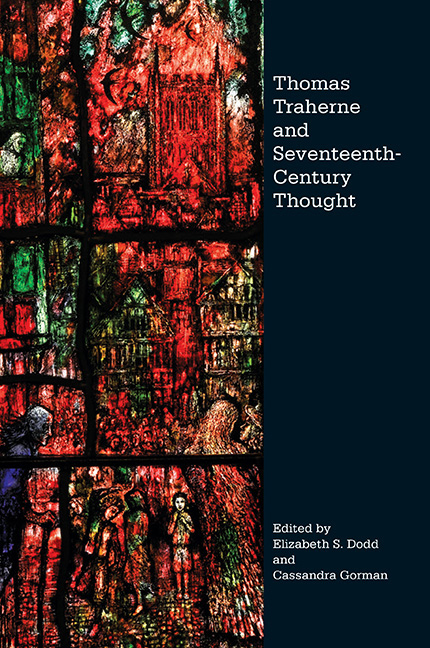Book contents
- Frontmatter
- Contents
- Contributors
- Acknowledgements
- Conventions and Abbreviations
- Foreword
- Introduction: ‘A lover of all Things … An Active ey’ (Select Meditations I.82): Traherne in Context
- PART I PHILOSOPHIES OF MATTER AND SPIRIT
- 1 ‘The Lanthorns Sides’: Skin, Soul and the Poetry of Thomas Traherne
- 2 No Things But In Thoughts: Traherne's Poetic Realism
- 3 Thomas Traherne and ‘Feeling Inside the Atom’
- 4 ‘Consider it All’: Traherne's Revealing of the Cosmic Christ in The Kingdom of God
- PART II PRACTICAL AND PUBLIC DEVOTION
- Afterword by Jacob Blevins
- Chronology of Traherne's Life and Contemporary Intellectual Developments
- Bibliography
- Index
- Index of Biblical References
- Studies in Renaissance Literature
1 - ‘The Lanthorns Sides’: Skin, Soul and the Poetry of Thomas Traherne
from PART I - PHILOSOPHIES OF MATTER AND SPIRIT
Published online by Cambridge University Press: 05 July 2016
- Frontmatter
- Contents
- Contributors
- Acknowledgements
- Conventions and Abbreviations
- Foreword
- Introduction: ‘A lover of all Things … An Active ey’ (Select Meditations I.82): Traherne in Context
- PART I PHILOSOPHIES OF MATTER AND SPIRIT
- 1 ‘The Lanthorns Sides’: Skin, Soul and the Poetry of Thomas Traherne
- 2 No Things But In Thoughts: Traherne's Poetic Realism
- 3 Thomas Traherne and ‘Feeling Inside the Atom’
- 4 ‘Consider it All’: Traherne's Revealing of the Cosmic Christ in The Kingdom of God
- PART II PRACTICAL AND PUBLIC DEVOTION
- Afterword by Jacob Blevins
- Chronology of Traherne's Life and Contemporary Intellectual Developments
- Bibliography
- Index
- Index of Biblical References
- Studies in Renaissance Literature
Summary
In one of the many icons from Francis Quarles's popular didactic work of 1635, Emblemes, a small figure stands, clad in a belted smock, his hands clasped in prayer. His arms emerge, as if through the bars of a prison cell, from between the ribs of a skeleton, which in turn sits in cross-legged contemplation, propping its skull-head on an osseous hand. Beneath the image runs a motto taken from Romans 7.24: ‘O wretched man that I am, who shall deliver me from the body of this death?’
Where the soft-featured, monkish figure represents the soul, the emblem's extended epigram demands that this skeletal ‘body of death’ be read as a true likeness of man's living flesh:
Behold thy darling, which thy lustfull care Pampers; for which thy restlesse thoughts prepare Such early cates: for whom thy bubbling brow So often sweats […] Behold thy darling, whom thy soul affects So dearly; whom thy fond indulgence decks And puppets up in soft, in silken weeds.
The repeated invocation that the reader ‘behold [his] darling’ insists that he recognise the discrepancy between his besotted affections and the degraded object on which he is loading them: namely, his mortal frame. Where the icon conspicuously flays the body back to unrelenting bone, the infatuated reader and the soul (who stand as one interlocutor) cosset the body's edges, enveloping them in ‘silken weeds’. In detailing this passion for the body, Quarles directs considerable attention to the very sensate superficies of which the icon has been stripped: the reader ‘decks’ and ‘puppets’ the body in ‘soft’, ‘silken’ weeds, while his own skin breaks a sweat in an agitation of affection so great that his brow ‘bubbles’.
Quarles's emblem is typical of a prevalent early modern tendency to equate the outsides of things with deception and the distractions of worldly vanity: the emblem's pictorial excoriation of the body seeks to assert epistemological control over the dangers of smooth skin and sensuous affections by reframing the body's tender and concupiscent composition as unforgiving bars of bone, and reducing its rich tissues to thin air.
- Type
- Chapter
- Information
- Thomas Traherne and Seventeenth-Century Thought , pp. 31 - 47Publisher: Boydell & BrewerPrint publication year: 2016



